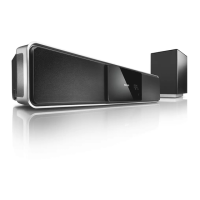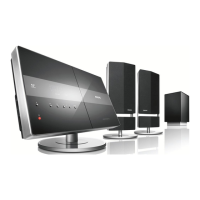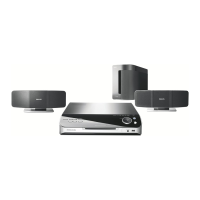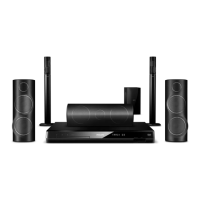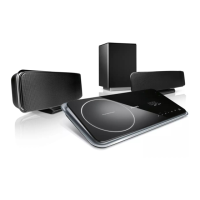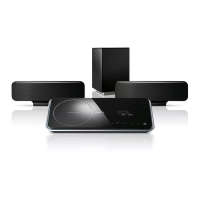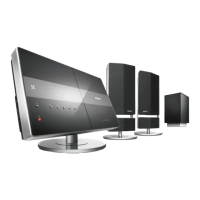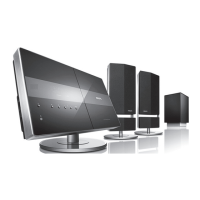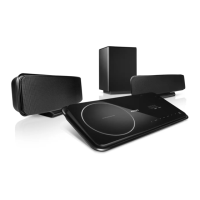Do you have a question about the Philips HTS6100/55 and is the answer not in the manual?
Essential safety warnings and precautions for unit operation.
Key features like video upscaling to 1080p and EasyLink functionality.
Overview of the SoundBar DVD Home Theatre unit and its capabilities.
Layout and functions of the remote control buttons.
Positioning the DVD Home Theatre unit and subwoofer.
Connecting the unit to a TV using HDMI, component, or composite video.
Connecting the subwoofer to the main unit.
Connecting FM and AM/MW antennas for radio reception.
Connecting external audio sources like TV, cable box, or game consoles.
Connecting portable media players via the MP3 LINK socket.
Connecting USB storage devices to play media files.
Instructions and precautions for wall-mounting the main unit.
Inserting batteries and preparing the remote control.
Selecting the desired input source for playback.
Using remote control buttons to navigate on-screen menus.
Setting the TV to the correct input for viewing content.
Initial setup for the Ambisound surround sound system.
Enabling progressive scan for enhanced picture quality.
Enabling HDMI CEC for simplified control of connected devices.
Mapping audio inputs to connected devices for automatic switching.
Choosing and switching between different input sources for playback.
Inserting and playing various types of discs.
Playing video content, controlling playback, and changing settings.
Playing MP3/WMA files, controlling tracks, and using playback modes.
Playing JPEG photos and creating slideshows.
Playing media files from USB storage devices.
Connecting and playing music from portable media players.
Tuning into FM/AM radio stations and improving reception.
Initial setup for automatic radio station installation.
Selecting radio bands, controlling playback, and managing presets.
Manual method for finding and saving specific radio stations.
Adjusting, muting, and unmuting the audio volume.
Modifying bass and treble tone levels for audio output.
Choosing the best surround sound output based on content.
Applying predefined sound modes like Action, Drama, or Sports.
Configuring basic settings like EasyLink, OSD Language, and Standby Mode.
Settings related to audio output, including Ambisound and HDMI Audio.
Adjusting video settings like TV Type, TV Display, and HDMI Setup.
Customizing preferences such as subtitle language, parental controls, and DivX settings.
Checking for and installing software upgrades for the unit.
Instructions on how to clean discs and the main unit screen.
Troubleshooting common problems with the unit's buttons and power.
Resolving problems related to no picture or HDMI connection.
Solutions for no sound from the unit, HDMI, or TV programs.
Troubleshooting DivX playback, subtitles, and USB content.
Essential safety warnings and precautions for unit operation.
Key features like video upscaling to 1080p and EasyLink functionality.
Overview of the SoundBar DVD Home Theatre unit and its capabilities.
Layout and functions of the remote control buttons.
Positioning the DVD Home Theatre unit and subwoofer.
Connecting the unit to a TV using HDMI, component, or composite video.
Connecting the subwoofer to the main unit.
Connecting FM and AM/MW antennas for radio reception.
Connecting external audio sources like TV, cable box, or game consoles.
Connecting portable media players via the MP3 LINK socket.
Connecting USB storage devices to play media files.
Instructions and precautions for wall-mounting the main unit.
Inserting batteries and preparing the remote control.
Selecting the desired input source for playback.
Using remote control buttons to navigate on-screen menus.
Setting the TV to the correct input for viewing content.
Initial setup for the Ambisound surround sound system.
Enabling progressive scan for enhanced picture quality.
Enabling HDMI CEC for simplified control of connected devices.
Mapping audio inputs to connected devices for automatic switching.
Choosing and switching between different input sources for playback.
Inserting and playing various types of discs.
Playing video content, controlling playback, and changing settings.
Playing MP3/WMA files, controlling tracks, and using playback modes.
Playing JPEG photos and creating slideshows.
Playing media files from USB storage devices.
Connecting and playing music from portable media players.
Tuning into FM/AM radio stations and improving reception.
Initial setup for automatic radio station installation.
Selecting radio bands, controlling playback, and managing presets.
Manual method for finding and saving specific radio stations.
Adjusting, muting, and unmuting the audio volume.
Modifying bass and treble tone levels for audio output.
Choosing the best surround sound output based on content.
Applying predefined sound modes like Action, Drama, or Sports.
Configuring basic settings like EasyLink, OSD Language, and Standby Mode.
Settings related to audio output, including Ambisound and HDMI Audio.
Adjusting video settings like TV Type, TV Display, and HDMI Setup.
Customizing preferences such as subtitle language, parental controls, and DivX settings.
Checking for and installing software upgrades for the unit.
Instructions on how to clean discs and the main unit screen.
Troubleshooting common problems with the unit's buttons and power.
Resolving problems related to no picture or HDMI connection.
Solutions for no sound from the unit, HDMI, or TV programs.
Troubleshooting DivX playback, subtitles, and USB content.
| HDMI Inputs | 1 |
|---|---|
| USB Playback | Yes |
| DVD Playback | Yes |
| Subwoofer type | Active |
| HDMI output(s) | 1 |
| Component video output(s) | 1 |
| Composite video output(s) | 1 |
| HDMI | Yes |
| Bluetooth | No |
| Supported Formats | MP3, WMA, JPEG |
| Sound System | Dolby Digital, DTS |
| Digital audio input(s) | 1 |
| Playable disc formats | DVD, CD, MP3-CD |
| Type | Home Theatre System |

